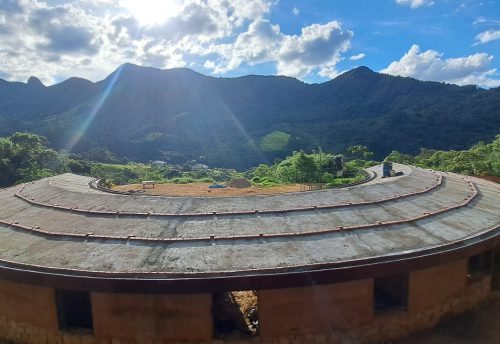
A significant advantage of cob is that it can be made using materials from the construction site itself, taking care to obtain them in a way that minimizes environmental impact and requires less use of resources. Having the source close, such as the land resulting from excavations on the site or in the vicinity, reduces costs and the energy lost – mainly for transportation.
Clay, sand, and straw will be needed to mix the cob. Depending on your soil, the content of 50% clay and 50% sand or 15% clay and 85% sand may work. The proportion of the materials is flexible and also makes it possible to make corrections with the addition of the missing component. Most of the sandy-clay soils are appropriate, requiring only the addition of straw.
The straw serves to increase the resistance and also to prevent cracks after drying. Its incorporation makes the mixture drier, requiring the addition of water to achieve the ideal consistency. Here at Eco Caminhos, we get straw brushing the grass and letting it dry in the sun for a few days.
For the preparation of the mixture, you will need a free, flat place and a tarp to throw the soil. You will mix and knead the clay, with the addition of straw and water until you get a firm, yet plastic consistency. This mixture can be made manually in groups (using shovels and kneading the clay with your feet) or with the help of machinery to speed up the process.
Testing is important to find a good mix for your soil. You can make test bricks by trying various recipes and combinations and figuring out which ones work best and are easiest to make. Excess sand makes the brick crumble when dry, and excess clay causes the brick to break. The amount of straw is difficult to quantify, but it is important that each straw is surrounded by the soil mixture.
A good combination of mixing and compression is a big part of the magic that transforms the ingredients of cob. In a short time of familiarization, you will start to have the tact to do so. Trust in yourself. Try it!
![[:en]Eco Caminhos: Permaculture & Agroforestry Farm in Brazil[:br]Eco Caminhos: Fazenda de Permacultura e Agrofloresta no Brasil[:sp]Permacultura y Agroforestería en Brasil: Eco Caminhos[:]](https://ecocaminhos.com/wp-content/uploads/2024/02/Eco-Caminhos-logo-without-border.png)

 Português
Português Español
Español




